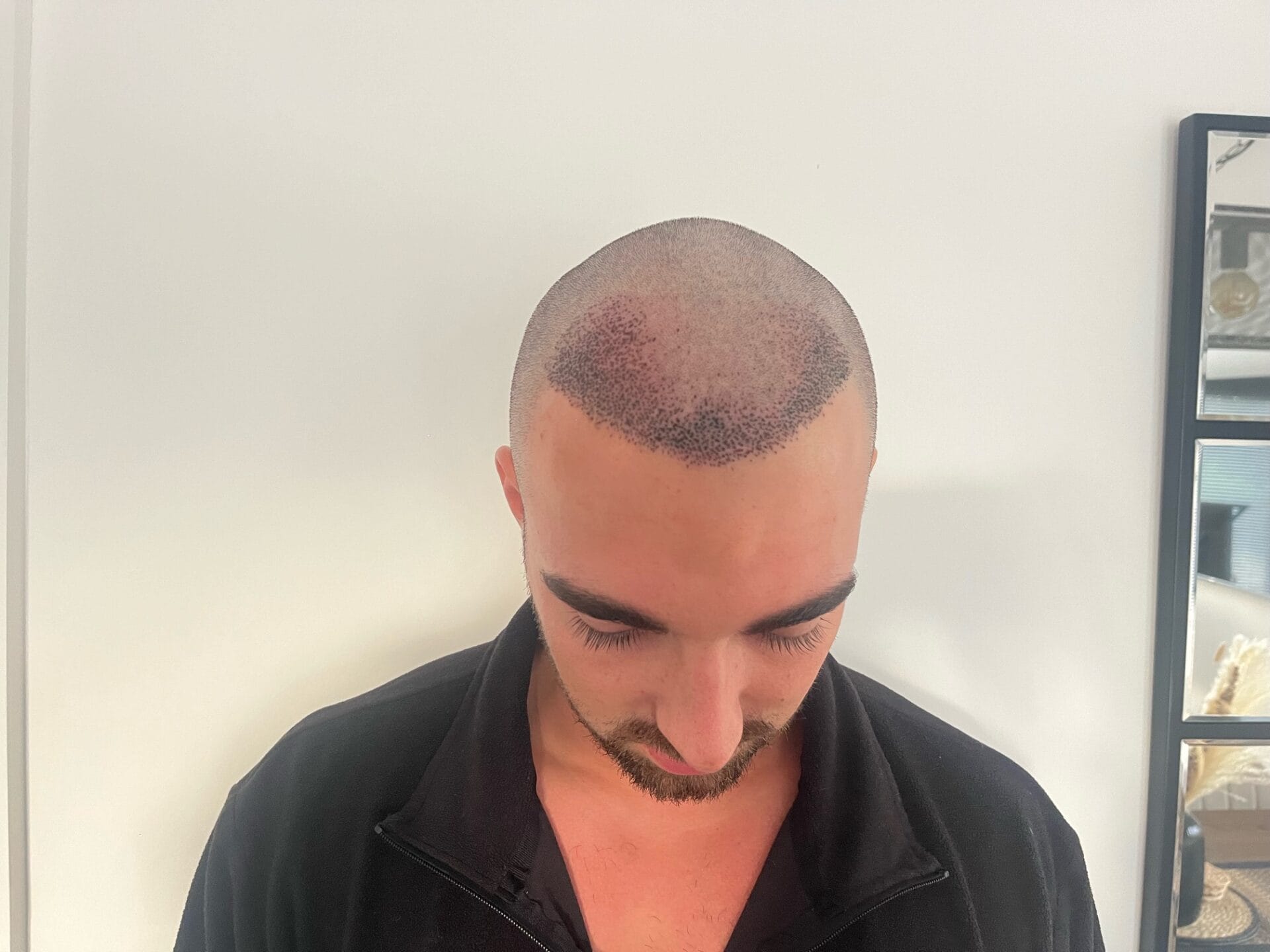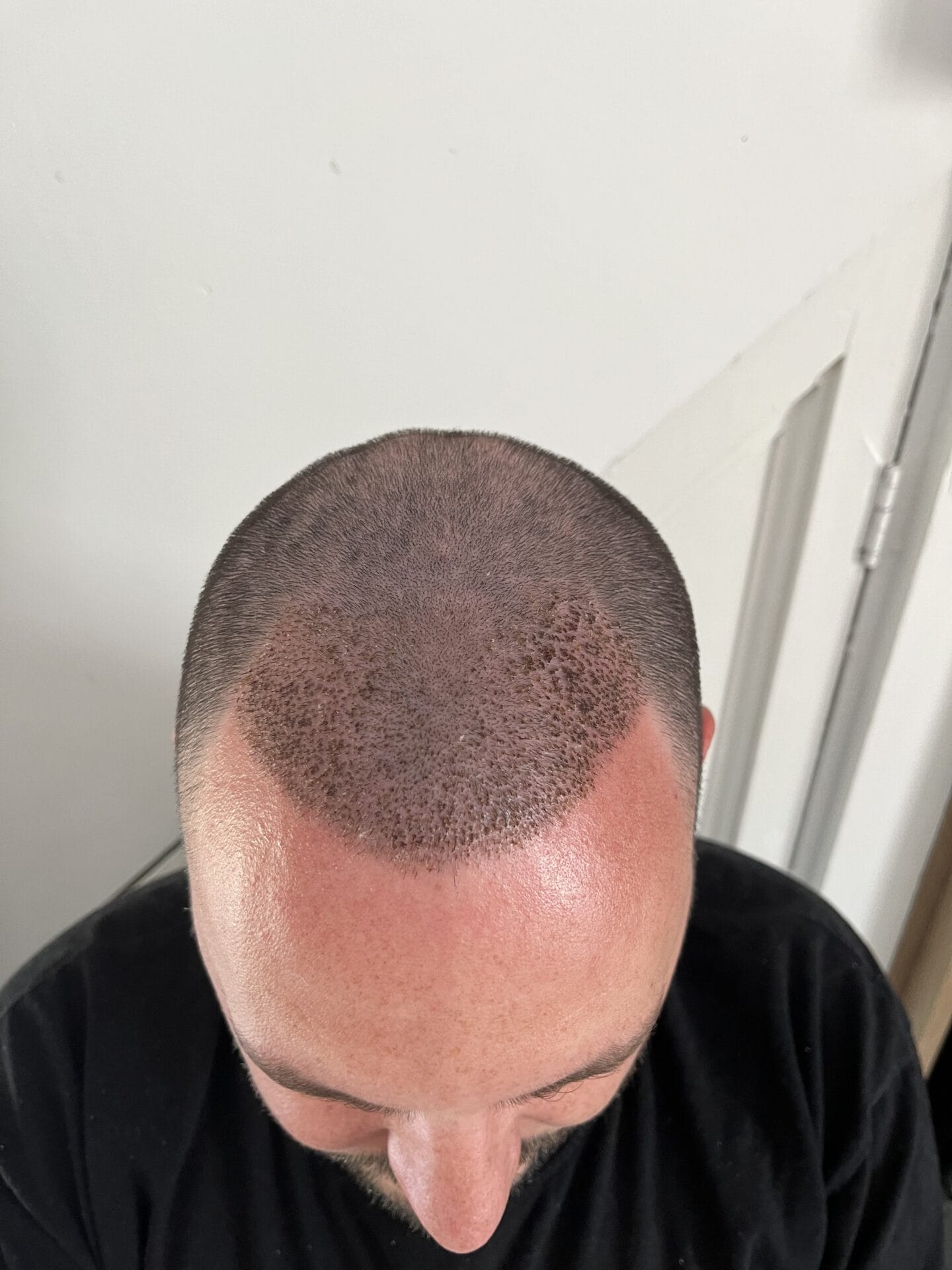Scabs after a hair transplant are a normal consequence of the procedure. Patients should not be alarmed if they notice the implanted hair follicles scab over temporarily. These scabs might appear like small, dried-up spots of blood. After the scalp heals over 7-10 days, they will eventually fall off, leading to normal hair growth.
There is no way to prevent red scabs after a hair transplant. However, it’s crucial to the recovery process that patients do not remove the scabs themselves. Learn more about managing these scabs below.
In this guide:
- Scabs after Hair Transplant: Why Do They Occur?
- How Long Do Scabs Last After a Hair Transplant
- Can I Remove Scabs After a Hair Transplant?
- Washing Scabs Away After Hair Transplant
- What Should I Do If the Scabs Don’t Fall Off?
Scabs after Hair Transplant: Why Do They Occur?
What is a scab? It’s a crust that forms over a wound after an injury to protect it from infections. Scabs are made from dried blood cells (platelets) that usually clot in a wound to form the crust. The scab remains for as long as the wound takes to heal1.
Scabs form after a hair transplant due to the cutting of the scalp. Hair transplants involve extracting hair follicles from a donor site, which are then inserted into micro-incisions at the recipient site. Each incision causes a break in the skin. Patients will notice individual red scabs after a hair transplant at each incision site. It’s a sign that the recovery process is going well.

How Long Do Scabs Last After a Hair Transplant
Scabbing doesn’t occur immediately after the surgery. Usually, scabs begin to develop 2-4 days after the hair transplant. The scabs peak around 3-4 days and disappear within 1-2 weeks2.
Each patient’s recovery timeline is different. Some patients notice the scabs relatively quickly and heal even faster. Meanwhile, others might take around 14 days to see their scalps return to normal. It’s not unusual for patients to report some mild itchiness or redness during this time. However, if the scalp appears extremely red or swollen, it can be a sign of infection.
The timeline doesn’t change for either type of hair transplant procedure. Follicular unit excision (FUE) involves a hole punch to remove each follicle, which is then inserted into the recipient site via microincisions. Follicular unit transplantation (FUT), on the other hand, involves strip harvesting, where a section of skin is removed from the back of the scalp3. The skin is cut into strips, which are then inserted into the recipient’s site.

Can I Remove Scabs After a Hair Transplant?
No. Avoid removing scabs yourself. Scabs are a normal part of the healing process. Disrupting this process will slow down your recovery and can lead to some serious consequences.
Scabs protect the implanted hair follicles from infection and inflammation, forming a protective crust. If you remove this crust, you risk introducing bacteria and other pathogens into the recipient site. This can cause an infection that may jeopardise the success of the hair transplant.
Picking at the scabs can also disrupt the underlying hair follicles. In the first few days following the transplant, the hair follicles are relatively unsecured. If the scab is removed, the follicles can fall out of the recipient site4. This will affect the final appearance of the transplant.

Washing Scabs Away After Hair Transplant
If scabs are a normal part of the healing process, how do you wash the recipient site without causing any damage? Your surgeon will provide detailed aftercare instructions relevant to your procedure. Always follow this advice over general recommendations.
Here are some tips:
- Avoid Immediately Washing Your Hair. The riskiest period is the first 72 hours post-transplant. The grafts remain insecure. Do not wash your hair during this period. Your grafts will need to settle into place.
- Use a Gentle Shampoo. Harsh shampoos or conditioners filled with fragrances and other chemicals can irritate your scalp. Any form of irritation risks the viability of a hair transplant. Use a mild, non-medicated shampoo5. If you’re unsure what to use, speak to your surgeon.
- Dilute the Shampoo. Applying the shampoo directly can disturb the scabs and grafts. Mix the shampoo with a small amount of lukewarm water to create a diluted solution. This can then be applied easily to the scalp. It is a nice method to wash your hair on the 4th day following surgery.
- Wash Gently. Avoid rubbing or massaging the area for the first 7-10 days. Let the shampoo sit for a minute before rinsing it off with lukewarm water. High-pressure showers can disrupt the scabs.
- Moisture the Scalp. If the scabs continue to persist for longer than 10-14 days, apply a light moisturising oil to soften the area before washing. Apply delicately to prevent any irritation or damage to the grafts.
- Pat Your Head to Dry. Minimise any rubbing of the recipient site. It’s best to pat the scalp gently using a cotton towel or let it air dry. Remember, the grafts are not anchored firmly into the scalp. Intensive rubbing will disrupt the grafts.
- Do Not Pick. Picking is extremely harmful to your grafts. Any itching, picking, or disruption will affect the success of your grafts. Moreover, it will cause further irritation, exacerbating the situation.
What Should I Do If the Scabs Don’t Fall Off?
As mentioned, some mild moisturisation is a sensible approach if your scabs persist for longer than 10 days. It can help soften the area. However, if your scabs continue for 2 weeks or more, it’s time to consult your original Surgeon.
Quick Takeaways
- Normal Timeline: Scabs usually develop 2–4 days post-transplant and fall off naturally within 7–14 days.
- Do Not Pick: Avoid removing scabs manually to prevent infections, scarring, or damage to the grafts.
- Gentle Washing: Use diluted, gentle shampoo and wash the scalp carefully after 72 hours, ensuring no rubbing or irritation.
- Persistent Scabs: If scabs remain beyond 14 days, consult your surgeon for advice—this may indicate slower healing or too much caution when washing.
Get In Touch With The Treatments Rooms London
A successful hair transplant depends on the skill of your surgeon. Here at The Treatment Rooms London, we work closely with patients to design a personalised plan that works for them. We’ll discuss the pros and cons of each approach, helping you make an informed decision.
Even after the procedure, we continue to support you every step of the way. If you’ve got any concerns about red scabs after a hair transplant, we’re here to help. We can answer your questions, prevent any complications, or refer you to another specialist. We’re committed to your transplant’s success.
Book a consultation today to learn more about our options. From FUE to FUT hair transplants, we’re leading industry experts. As the winner of Hair Restoration Clinic of the Year 2023, we know you won’t see better results anywhere else.
References
- Phillips SJ. Physiology of wound healing and surgical wound care. ASAIO journal. 2000 Nov 1;46(6):S2-5. Available at: https://journals.lww.com/asaiojournal/fulltext/2000/11000/Physiology_of_Wound_Healing_and_Surgical_Wound.29.aspx/1000
- UnitedCare. Scabs After a Hair Transplant – Should You Worry? (A Dermatologist’s Answer). Available at: https://www.unitedcareclinic.com/blog/hair-transplant-scabs/
- Sharma R, Ranjan A. Follicular unit extraction (FUE) hair transplant: curves ahead. Journal of maxillofacial and oral surgery. 2019 Dec;18(4):509-17. Available at: https://link.springer.com/article/10.1007/s12663-019-01245-6
- Bernstein RM, Rassman WR. Graft anchoring in hair transplantation. Dermatologic surgery. 2006 Feb;32(2):198-204. Available at: https://onlinelibrary.wiley.com/doi/abs/10.1111/j.1524-4725.2006.32033.x
- Schweiger D, Schoelermann AM, Filbry A, Hamann T, Moser C, Rippke F. Highly efficient and compatible shampoo for use after hair transplant. Clinical, Cosmetic and Investigational Dermatology. 2015 Jul 22:355-60. Available at: https://www.tandfonline.com/doi/abs/10.2147/CCID.S86015
Share:
Authored by
Reviewed by
Book a Consultation
Related Blogs
Ariana Grande Hair Loss: Prevention, Styling Secrets, and Hypothetical Transplant Solutions
April 10, 2025
Ariana Grande, the global pop sensation renowned for her signature high ponytail and bold hairstyles, has openly…
Daniel Craig Hair Transplant: Before, After and His Hairline
April 10, 2025
Daniel Craig, the world-famous English actor who gained international fame as the fast-paced, debonair James Bond, has…
Rob Brydon Hair Transplant: Before, After, and His New Hairline
April 8, 2025
Rob Brydon, the beloved Welsh comedian and Gavin & Stacey star, has traded his receding hairline for…
Gordon Ramsay Hair Transplant: Before, After, and His New Hairline
April 3, 2025
Gordon Ramsay, the fiery Michelin-starred chef, restaurateur, and TV personality, has swapped his receding temples for a…
Has Perez Hilton had a hair transplant? All You Need to Know
April 2, 2025
Perez Hilton is a familiar face in the media. He is known for his work as a…
Ronnie Vint – Love Island Hair Transplant: Before, After, And His Hairline
March 31, 2025
Ronnie Vint, a former footballer and current TV personality, appeared on the 2024 season of “Love Island”…
Prince Harry Hair Loss: Speculations, Treatments, and Possible Transplant Options
March 28, 2025
Prince Harry, the Duke of Sussex and beloved royal-turned-global humanitarian, has sparked global curiosity over his ever-evolving…
Elton John and His Hair Transplant Journey
March 27, 2025
Sir Elton John has had one of the greatest careers in music. Since his rise to fame…
Elon Musk Hair Transplant: Before, After and His New Hairline
March 26, 2025
Elon Musk, the billionaire behind Tesla and SpaceX, is a well known figure for his innovations and…











